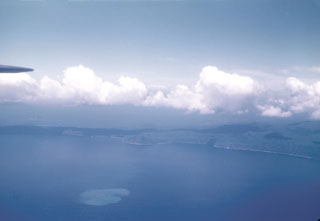Report on East Epi (Vanuatu) — 25 January-31 January 2023
Smithsonian Institution / US Geological Survey
Weekly Volcanic Activity Report, 25 January-31 January 2023
Managing Editor: Sally Sennert.
Please cite this report as:
Global Volcanism Program, 2023. Report on East Epi (Vanuatu) (Sennert, S, ed.). Weekly Volcanic Activity Report, 25 January-31 January 2023. Smithsonian Institution and US Geological Survey.
East Epi
Vanuatu
16.6797°S, 168.3893°E; summit elev. 833 m
All times are local (unless otherwise noted)
The Wellington VAAC reported that a low-level plume of ash and sulfur dioxide from a new eruption at Epi was identified in satellite data at 0730 on 31 January. According to the Vanuatu Meteorology and Geo-Hazards Department (VMGD) residents saw steaming at the ocean’s surface in the area over the vents at around 0748, and phreatic explosions that ejected steam and tephra 100 m above the water. The Alert Level was raised to 1 (on a scale of 0-5) and the public was warned to stay 10 km away from the East Epi submarine volcano. Observers reportedly saw a growing cone from ongoing ash emissions. The VAAC noted that the eruption was short-lived and had ceased by 1548; the ash had dissipated.
Three submarine cones, Epi A, Epi B, and Epi C, and smaller cones and craters, are located 10-16 km NNE from the summit of Epi Island and are aligned along the N rim of an inferred caldera. Epi B is the shallowest of the seamounts and has been historically active, most recently in February 2004. A March 2004 bathymetric survey revealed that Epi B was about 300 m tall, with a diameter of about 1.8 km at the base. The summit crater was about 150 m in diameter and the crater floor was at a depth of 90 m. The highest point was on the NW rim of the summit crater, at a depth of 34 m.
Geological Summary. The submarine East Epi group of basaltic and dacitic cones are located within a possible 10-km-diameter caldera off the NE coast of southern Epi Island in Vanuatu. Three cones (1-1.5 basal diameter), known as Epi A, Epi B (or Cioan), and Epi C, are located along the northern rim of the inferred caldera, though Beier et al. (2018) suggest an alternate to the post-caldera formation model. A few smaller cones are south of Epi B. Ephemeral islands were formed during eruptions at Epi B in 1920 and 1953. Explosive activity was reported in 1958 and 1960, discolored water was often seen during 1971-1974 and 1988, a new vent was detected in 1979, and explosive activity occurred in 1999, 2002, 2004, and 2023. The summit was at 34 m below sea level at the time of a 2001 survey, and a research cruise in 2013 (R/V Sonne SO-229; Haase et al, 2013) sampled six cones, including "very fresh pumice and lava bombs" from Epi B and "relatively old-looking" material from the others. The SO-229 cruise also recovered rhyodacitic pumice with mafic streaks, similar to that sampled by previous cruises, and described Epi B as "covered by massive blocks of pumice."
Sources: Vanuatu Meteorology and Geohazards Department (VMGD), Wellington Volcanic Ash Advisory Center (VAAC)

